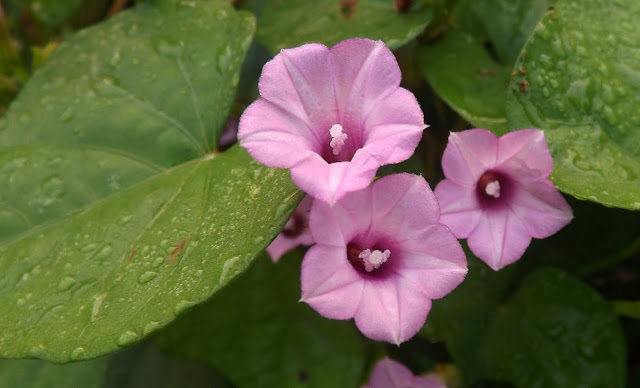Khudey ghonti or Littlebell, Ipomoea triloba
Khudey ghonti or Littlebell (Ipomoea triloba, family: Convolvulaceae) is a twining annual creeper, attaining a lengthe of 2-3 m. The creeper is usually found scattered on the ground or on a bush. Stem is usually hairy, slender or angular and green, sometimes reddish. It creeps or climbs by grabbing something by using its tendril-like new shoots. When a part of its body is injured or its leaves are crushed it releases a kind of milky substance. Although it is a tropical American species, it has adapted well to tropical areas of Asia and Africa. The water-loving creeper is found beside the waterbodies, ditches and roadsides of Bangladesh.
Other names: Ghonta kolmi (Bang), Three-lobed morning glory (Eng).
The leaves of the members of the Morning glory family are usually varied in size and shapes. No exceptions are observed in this case. These are usually three-lobed but can also be heart-shaped, especially the young leaves. Leaves are thin, minutely hairy, long-petioled, light green in color, 3-7 cm long and 2-4 cm wide, cordate at base, acute at tip.
The tiny flowers originate from the leaf axils, usually single but sometimes a few; bell-shaped, 5-lobed, 2 cm long. Theses are purple or milk white. Flowering and fruiting occur from autumn to spring.
Fruit is round capsule, dehiscent, Seeds 2-4, brownish. Propagation of the plant is caused by seeds. By the by, the species name 'triloba' is derived from its three-lobed leaves.
Synonyms: Batatas triloba, Convolvulus dentatus, Convolvulus ipomoea, Convolvulus sloanei, Convolvulus subquinquelobus, Convolvulus trilobus, Ipomoea blancoi, Ipomoea galapagensis, Ipomoea mariannensis, Ipomoea parviflora, Ipomoea triloba var. quinqueloba, Ipomoea webbii, Quamoclit triloba, Sanilum parviflorum





0C61F9E1AB
ReplyDeleteCanli Web Cam Show
Görüntülü Sex
Whatsapp Görüntülü Show